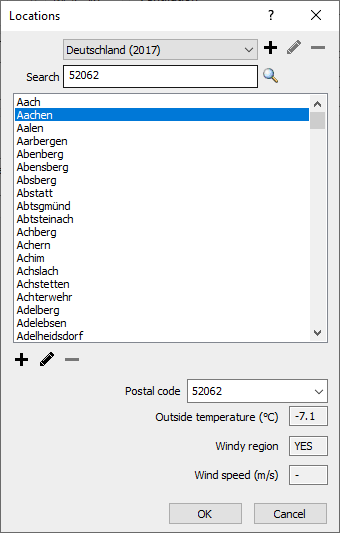Details on Locations
Information about the Locations dialog in the General heat load data.
You are here:

Dataset selection
Defines the dataset used. The locations stored in the data set are displayed in the dialog's selection window after the dataset has been selected. For Germany and Switzerland there are two options, with data from 2003 and 2017, or 2017 and 2020 respectively.
 : Opens the Create or edit region/place dialog, in which you can create your own datasets, e.g. for a country or region.
: Opens the Create or edit region/place dialog, in which you can create your own datasets, e.g. for a country or region.
 : Opens the Create or edit region/place dialog where you can change the name of the dataset. This button is enabled only for self-created datasets.
: Opens the Create or edit region/place dialog where you can change the name of the dataset. This button is enabled only for self-created datasets.
 : Allows you to delete datasets that you have created yourself.
: Allows you to delete datasets that you have created yourself.
Search
Enter the postal code or the name of the city where your project is located.
Location
List for selection of project location.
 : Opens the Create or edit region/place dialog where you can add new locations.
: Opens the Create or edit region/place dialog where you can add new locations.
 : Opens the Create or edit region/place, where you can edit data of the selected location or add more postal code areas for the location.
: Opens the Create or edit region/place, where you can edit data of the selected location or add more postal code areas for the location.
 : Deletes self-created or supplied and edited locations or resets them to the default settings.
: Deletes self-created or supplied and edited locations or resets them to the default settings.
Postal code
The postal code of the selected location. If all the postal codes of a location are available in the selected dataset, the desired postal code can be selected via the drop-down list. For cities in Switzerland this field remains empty.
Outside air temperature (°C)
The standard outdoor temperature of the selected location or postal code area.
Windy region
If the selected dataset contains information relating to the wind speed at the selected location, it is shown here. If no information on wind strength is present in the record, a windless region is the default setting.
Wind speed (m/s)
Displays the wind speed stored for the location. The value is used to determine ventilation heat losses due to infiltration and is only relevant for calculations according to the Russian heat load standard SP 60.